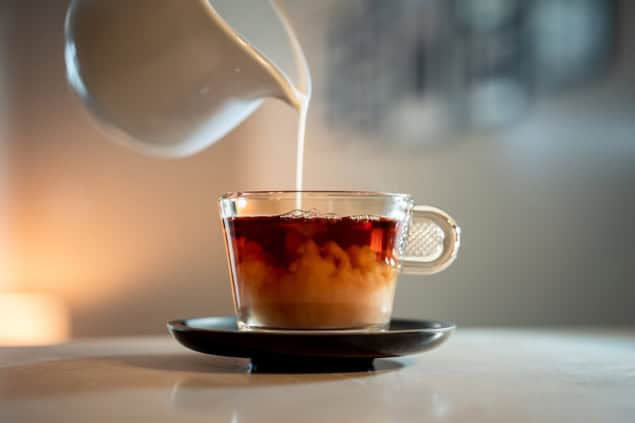Megan Povey reviews Physics in the Kitchen by George Vekinis

There’s a lot of physics in a cup of tea. Compounds in the tea leaves start to diffuse as soon as you pour over hot water and – if you look closely enough – you’ll see turbulence as your milk mixes in. This humble beverage also displays conservation of momentum in the parabolic vortex that forms when tea is stirred.
Tea is just one of the many topics covered in Physics in the Kitchen by George Vekinis, director of research at the National Research Centre “Demokritos” (NCSRD) in Greece. In writing this book, Vekinis – who is a materials physicist by training – joins a long tradition of scientists writing about cooking.
The book is full of insights into the physics and chemistry underlying creative processes in a kitchen, from making sauces and cooking vegetables to the use of acid and the science behind common equipment. One of the book’s strengths is that, while it has a logical structure, it is possible to dip in and out without reading everything.
Talking of dips, I particularly enjoyed the section on sauces. My experience in this area is confined to rouxs that are thickened with flour, and I was surprised to discover that Vekinis considers this to be a “bit of a cheat”. Sauces prepared in the “Greek way”, he points out, often don’t involve starch at all.
Instead, a smooth sauce can be made just by heating an acid such as wine or lemon with egg and broth. This ancient method, which the author describes in a long section on “Creamy emulsion or curdled mess?”, involves the extraction of small molecules and requires extra care to prevent curdling or splitting.
However, as a food physicist myself, I did have some issues with the science in this and later sections.
For example, Vekinis uses the word “gel” far too loosely. Sometimes he’s talking about the gels created when dissolved proteins form a solid-like network despite it mostly being liquid – such as the brown gel that appears below a roast ham or chicken that has cooled. However, he also uses the same word to describe what you get when starch granules swell and thicken when making a roux sauce, which is a very different process.
Moreover, Vekinis describes both kinds of gel as forming through “polymerization”, which is inaccurate. Polymerization is what happens when small molecular building blocks bond chemically together to form spindly, long-chain molecules. If these molecules link up, they can then form a branched gel, such as silicone, which has some structural similarities to a protein gel. However, the bonding process is very different, and I found this comparison with polymer science unhelpful.
Meanwhile, in the section “Wine, vinegar, and lemon”, we are told that to prepare a smooth sauce you have to boil “an acidic agent as a catalyst for a polymerization reaction” and that “dry wine does the job too”. Though the word is sometimes used colloquially, what is described here is not, in the scientific sense, a catalytic reaction.
Towards the end of the book, Vekinis moves beyond food and looks at the physics behind microwaves, fridges and other kitchen appliances. He describes, for example, how the oscillation of polar molecules such as water in microwaves produces heating that is completely distinct to a conventional oven.
It’s well known that a microwave oven doesn’t heat food uniformly and the book describes how standing waves in the oven produce hot and cold spots. However, I feel more could have been said about the effect of the shape and size of food on how it heats. There has been interesting work, for example, investigating the different heating patterns in square- and round-edged foods.
Overall, I found the book an enjoyable read even if Vekinis sometimes over-simplifies complicated subjects in his attempts to make tricky topics accessible. I shared the book with some teacher friends of mine, who all liked it too, saying they’d use it in their food-science lessons. They appreciated the way the book progresses from the simple (such as heat and energy) to the complex (such as advanced thermodynamic concepts).
Physics in the Kitchen is not meant to be a cookbook, but I do wonder if Vekinis – who describes himself as a keen cook as well as a scientist – could have made himself clearer by including a few recipes to illustrate the processes he describes. Knowing how to put them into practice will not only help us to make wonderful meals – but also enhance our enjoyment of them too.
- 2023 Springer £17.99hb 208pp



